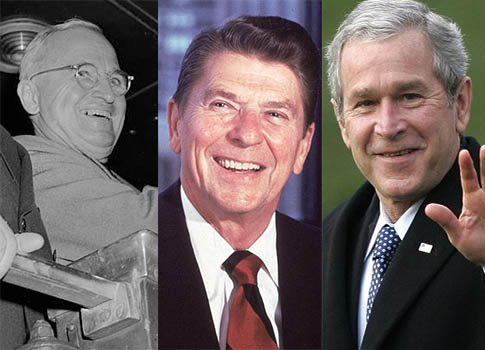"Reduced to its essence, grand strategy is the intellectual architecture that lends structure to foreign policy; it is the logic that helps states navigate a complex and dangerous world."
With President Obama’s foreign policy in disarray, Hal Brands’ study of strategy is well timed. Considering the experiences of four presidents—Truman, Nixon, Reagan, and Bush—Brands seeks to "offer some tentative thoughts on the utility of grand strategy for American officials."
The author’s intention is clear. There’s a scholar’s passion to this writing—a belief in history’s ability to illuminate the complexities of the present. But, if Brands has written an intellectually invigorating work, his accounting of four presidents also testifies to the hard choices of American policy.
Brands starts with Truman, explaining how his grappling with rising Soviet power was restricted by the fact that "grand strategy requires unity of effort and long-range planning, but neither of these virtues was in abundance."
Still, Truman engaged his officials in a strategy to restrain Soviet encroachment. At the heart of this agenda was a prioritization of interests. Truman was keenly aware that America’s limited resources meant that tough choices were inevitable. And here, Truman recognized that Western Europe was "the decisive theatre." He feared that were the Soviet Union to seize this locale, it might become "almost impregnable."
Truman was therefore determined to "derive maximum utility from finite resources." For Brands, Truman’s success was a function of his flexibility. Truman came to recognize that the ‘Marshall Plan’ to aid Europe could not co-exist without security and created NATO to provide this anchor.
We see Truman’s willingness to draw (and hold) red lines at critical junctures—most notably, in confronting North Korea’s invasion of South Korea. The author quotes Truman’s adviser Charles Bohlen, who said, "All Europeans to say nothing of the Asiatics are watching to see what the United States will do." Ultimately, Brands concludes that Truman’s grand strategy worked because of its responsiveness to rapidly changing events. As he puts it: "Containment … did not spring forth fully formed from the mind of George Keenan; it was an idea whose practical implications had to be worked out—and reworded out—amid the myriad crises and shocks of the day."
After Truman, Brands takes us inside the grand strategy of Kissinger. In Kissinger’s 1970 warnings against America becoming "a fireman running from one conflagration to another," one sees similarities with the Obama doctrine. Perhaps the greatest strength of Brands’ book is its ability to stimulate new analytical thinking on present concerns.
Desperate to rebalance American interests during the Vietnam War, Kissinger focused on China. Although Kissinger’s hand to China was a stroke of brilliance, Brands helps us to understand how American power limitations pushed the otherwise powerful secretary of State into a deliberate strategy of risk.
As he writes, "Amid global power shifts and U.S. retrenchment, a daring—even dangerous—approach to crisis management seemed essential." While the Kissinger-Nixon record was mixed, Brands uses their tenure to challenge our consideration of another demand of grand strategy: domestic politics. Brands suggests that the "biggest flaw" of Kissinger’s grand strategy was his idea that it "had to be executed independently of, and even in opposition to, the institutions and the society it was meant to serve." Disconnected from 1970s concerns like human rights, and fragmented by divisions among agencies of government, Kissinger’s grand strategy became "politically untenable."
Following Nixon-Kissinger is Reagan. Outlining Reagan’s evolution from a hardline stance to a more calculating one, Brands relates how Reagan won Gorbachev’s respect. On human rights, for example, we witness Reagan’s behind-the-scenes persuasion of Gorbachev to liberalize Soviet society. Brands records how Soviet exit visas increased from 1,000 to 80,000 between 1986 and 1988.
Recognizing the Soviet Union’s economic disrepair and growing liberation movements in Eastern Europe, Reagan offered Gorbachev a choice. On one hand, continued military expenditures would bankrupt the Soviet Union. On the other hand, rapprochement might save the Soviet Union, while balancing international security more firmly under American authority.
Gorbachev’s realism played an important role. However, Reagan’s purposeful vision was critical. Brands is cautious to avoid a biased appraisal of America’s 40th president. He records the deficits that accompanied Reagan’s defense expenditures. He says that Reagan’s single-minded focus on communism may have led him to neglect other American interests such as the rise of Islamist extremism in Pakistan. The author’s implicit warning is clear: Presidents must look beyond the immediate challenge.
Finally, Brands offers his thoughts on George W. Bush’s grand strategy. The terrorist attacks of Sept. 11, 2001, caused Bush to fundamentally reassess his vision of American power and foreign threats. Bush became fixed on the threat posed by Saddam Hussein’s possession of WMDs. Brands is fair in his understanding of this concern, but criticizes Bush for failing to assert sufficient control over his administration’s policy during the occupation of Iraq. In his discussion of Paul Bremer’s de-Ba’athification process, which helped spur the insurgency, Brands takes up one of the contradictions of grand strategy: A president must implement his policy, but also ensure that his subordinates carry out his policies effectively. However, Brands also praises Bush for his decision to launch the surge in Iraq. Here, we see another requirement of grand strategy: the necessity of bold leadership.
The conclusion of What Good is Grand Strategy? is particularly special. It encapsulates its author’s passion for his subject. Suggesting 10 ideas to guide future grand strategy, Brands ties together the various strands of his comprehensive work. For me, his fourth proposal is the most valuable: "Think of grand strategy as a process, not as a blueprint."
This is a lesson to which presidents, including the incumbent, would do well to pay heed.
